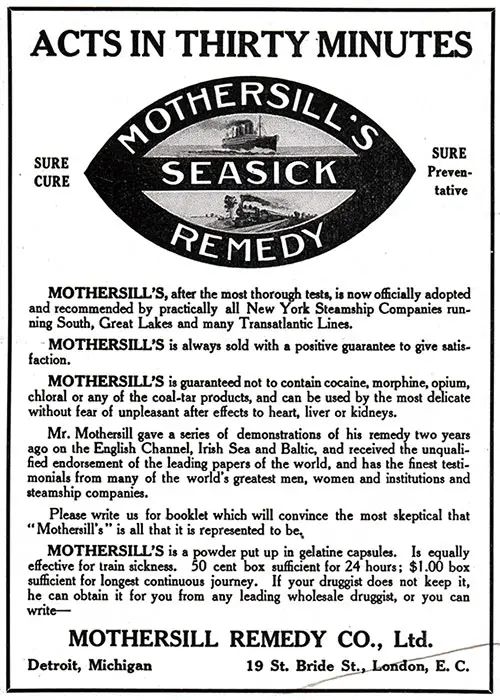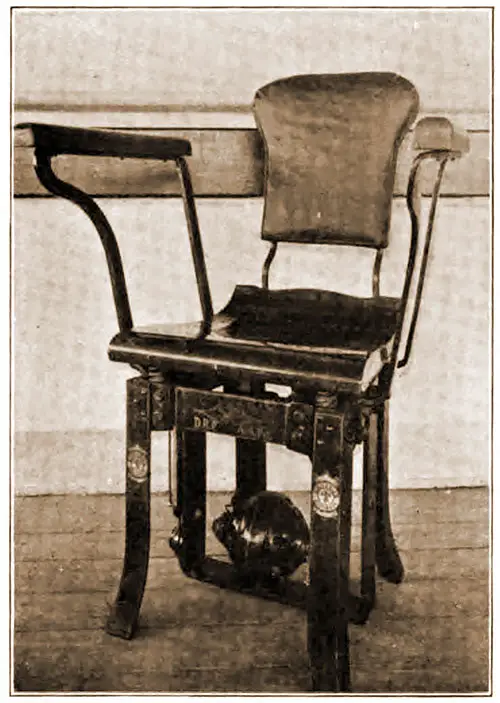Seasickness and Remedies

Advertisement for Mothersill Seasickness Remedy, North German Lloyd Bulletin, October 1911. GGA Image ID # 17bc55a4c1
The subject of seasickness is an all-important one to eighty percent of the ocean travelers. It must be said that the boats of large tonnage have minimized this distressing ailment to a remarkable degree; the bilge keels have also tended very materially to reduce this discomfort.
The causes and etiology are as yet imperfectly understood. Some hold the cause depends upon the altered or affected functions of the nervous centers, others refer the cause to the regurgitation of bile into the stomach, and still, others to irritate the liver by the body's unusual movements.
There is something to be said for each one of these alleged causes, but one thing is very certain, that when a landsman goes to sea, unless he is an excellent sailor, the movements of the ship and the shifting lines and surfaces unsettle his visual stability, as the different inclinations unsettle his muscular sense.
Thus, the consequent derangement caused reactions on the nerve centers and upon the visual sense, this producing nausea, and vomiting.
Persons with particularly irritable stomachs or of the highly sensitive nervous system are particularly liable to seasickness, while with certain individuals, the symptoms of seasickness are exhibited simply by going on a vessel at a pier. In this case, imagination is a potent factor.
Visual impressions predispose travelers to seasickness, suggesting that a sensitive individual when on deck, should shut his eyes.
Many preventive measures have been suggested, and numerous nostrums have been sold for this purpose, but preventive measures are practically limited to diet regulation before a voyage.
Food for some days previous to sailing should be plentiful, but of a light and nutritious character; food should not be taken for at least five or six hours before going on board. The bowels should be kept open with saline aperient water or by calomel.
If you are susceptible to seasickness, always get as near the center of the dining saloon as possible, and try to get as near the companionway as possible. Grape-fruit, limes, etc., are excellent and, in cases of seasickness, also brandy and ice in small doses. Many doctors recommend Champagne for this ailment; it should be taken in small doses, using a champagne tap.
Use Hunyadi or Apenta water freely or laxative salts. A hot-water bag placed at the pit of the stomach is sometimes efficacious. Three or four drops of chlorobrom on a lump of sugar often prevents a bad attack of illness. Considerable doses of sodium bromide and antipyrine often give relief.
The best all-around remedy is chloroform; this is a combination of chloramide and potassium bromide. It should be noted that this is not chloroform. Ammonium bromide is often efficacious.
Great care should be used in eating if you are disposed to seasickness. All greasy meats, pastry, etc., should be eschewed. Ham and bacon, pork in all forms, should be left severely alone.
Of all beverages, beer and stout are undoubtedly the worst for those who are predisposed to seasickness.
Remain on deck as much as possible if you feel ill, and get as far away from your neighbors who are ill as space will permit.
Remember that seasickness is only a matter of two or three days in most cases; in most instances, symptoms are all over by the third day. By the fourth day, the traveler could visit the steerage with impunity.
However, some travelers are always sick from port to port, and they naturally dread the voyage intensely. There is very little hope for the comfort of people who are so afflicted. A little aromatic ammonia or cologne water is often very pleasant in cases of illness.
The ship's doctor can do very little to relieve passengers who are seasick. If they knew of a successful remedy, they would hardly be in the merchant marine service, as they would be enabled to put a reliable preparation on the market with great profit to themselves.
One remedy recommended is morphine in small doses, say a fiftieth of a grain. However, the writer remembers an instance when one-fiftieth of a grain of morphine was used and the traveler who took it was the only one sick out of over five hundred passengers.
Enough has been said about this disagreeable concomitant of the sea, except to give a few more "remedies":
Mosel-Lavalee recommends as a remedy for seasickness the following preparation :
- Menthol: 0.1 gramme.
- Cocaïne hydrochloride: 0.2 gramme.
- Alcohol: 60.0 grammes.
- Sirup: 30.0 grammes.
A dessertspoonful to be taken at intervals of half an hour. The following is recommended by a physician, as a preparatory treatment, to be begun before the trouble manifests its presence :
- Sodium bromide: 4 drachms.
- Ammonium bromide: 2 drachms.
- Peppermint water: 3 ounces.
A teaspoonful before meals and at bedtime. Begin treatment three days before going on board. When preparatory treatment has been neglected, and the difficulty fully established, put a teaspoonful in half a tumblerful of water, add a drop of fluid extract of Ipecac, and give a teaspoonful every five minutes. It is said to generally relieve in less than half an hour.
Another doctor recommends the following :
- Oxalate of cerium: 2 grains.
- Tincture valerian ammoniated: 1 drachm.
- Water 1 ounce.
Take at one dose.
A German doctor gives the following, not as an absolute preventive, but as producing good results:
- Sulphate of atropine: 1/2 grain.
- Sulphate of strychnine: 1/2 grain.
- Peppermint water: 10 fl. drachms.
Fifteen minims of this solution is said to give a patient ease within half an hour of the time it is used hypodermically. The doctor does not depend wholly upon the above formula but falls back on the following when the other fails him:
- Caffeine: 64 grains.
- Salicylate of sodium: 48 grains.
- Distilled water: 160 minims.
A solution of the above is to be made with the aid of gentle heat. The remedy is administered hypodermically, the same as the former solution.
Chair Prevents Seasickness

Vibrating Chair for Preventing Seasickness, Technical World Magazine, July 1906. GGA Image ID # 17bbc4d41a
A chair has been designed to prevent seasickness. This chair has been actually tested on a voyage, and many passengers who were severely upset by the pitching of the ship declared that while they were in the chair they felt no had effects whatever, but when they no longer used it; the seasickness in some cases at once returned, although not in others.
The chair is operated by a motor which serves to give the seat and back motion; the long movements of the vessel are thus broken up and are constantly interrupted by brief movements in the opposite direction, thus counteracting the causes which produce seasickness.
Despite the numerous methods that have been suggested in the course of the last few decades of avoiding seasickness, this is still the most severe inconvenience of a sea journey.
Neither the chemical remedies of modern medicine nor the mechanical devices suggested (for instance, a cardanic (note 1) suspension of the berth) have met any success.
Finally, the fitting of rotating tops into the ship's body—a method devised by Herr Schlick of Hamburg—might prove effective in diminishing the risks of seasickness.
Still, no definite opinion on its effectiveness can be formed until the present experiments have been concluded.
However, a novel process of a physical kind has been tested recently, with the most excellent results, on the steamship Patricia of the Hamburg-America Line and the channel steamer Peregrine.
This is based on a vibrating motion. The outfit is of great simplicity and merely comprises a comfortable chair, the seat of which is set rapidly vibrating up and down by the force of an electro-motor connected to the electric lighting mains of the steamer.
Those wishing to protect themselves against the dreaded sickness should sit down on the vibrating chair when they feel about the same sensation as in riding in an automobile.
The vibratory motion makes the ship's rolling and pitching less felt. The vessel's slow downward movement is counteracted by the numerous short vibratory shocks occurring in an upward direction.
The apparatus is the invention of Messrs. R. & W. Otto, of Berlin, Germany. On the Patricia, on a recent trip from Hamburg to New York and back, as soon as passengers felt the approach of sickness, they sat down on the vibratory chairs, when it removed any uneasiness, either immediately or after a short stay on the chair.
Most of the patients remained free from the illness throughout the journey, even after leaving the chair. Simultaneously, in some other cases, the sickness returned a few hours after leaving the chair to disappear and finally be removed entirely after another treatment.
In the third series of cases, mainly comprising extremely susceptible persons, the characteristic symptoms of seasickness, after having been kept away during the stay on the vibrating chair, would immediately return on leaving the latter.
Accordingly, these passengers remained for hours (in some cases up to ten hours) in the chair. Still, even in the case of so prolonged a treatment, no noxious effect was observed.
Everybody agreed on the pleasant effects of a stay in the chair, and many even took their meals there. Not a single case of the “return of the swallows” was recorded.
The writer is indebted for the above particulars to one of the inventors, who, after invariably suffering from seasickness in his numerous trips across the Channel, did not experience the least uneasiness on a recent journey, even in stormy weather, when testing his vibrating chair.
The latter thus seems, at last, to afford the long-sought remedy against this dreaded illness. The much-discussed idea of “floating sanatoria” will now be susceptible to realization.
While being mainly a means of preventing the illness, the new apparatus has also been found efficient in some cases of advanced seasickness. The device has been patented in all countries.
Note 1: The cardanic suspension unit comprises an external frame, a middle frame, and a platform; the outer frame takes the form of a half-fork bracket with an axis of rotation aligned along the course axis.
The middle frame takes the form of a fork bracket with an axis of rotation aligned along the banking axis; the platform has an axis of rotation aligned along the pitch axis.
Dr. A. Graden Witz, "To Prevent Seasickness," in The Technical World Magazine, Vol. V, No. 5, July 1906, pp. 562-563.
